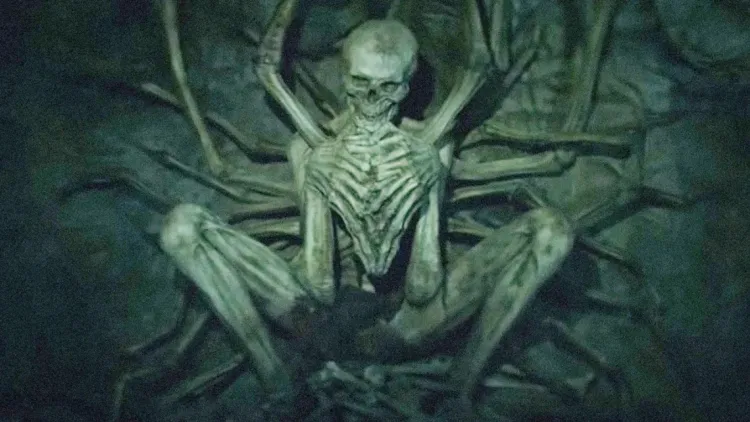Tabletop RPG Sleepaway makes gender expression part of the fun

(For the month of October, the Wednesday freelance newsletter is moving to Fridays, as I'm taking the month off from recapping. Each week, I’m publishing a new pop culture essay from a freelancer. Remember: Your subscription fee helps me pay these freelancers for their efforts! This week: Alex Viney on the wonderful gender exploration options in the tabletop RPG Sleepaway.)
Sleepaway first caught my eye because of its premise. The horror tabletop roleplaying game is a collaborative storytelling experience where players are counsellors struggling against the strange forces surrounding the American summer camp they work at, as well as the Lindworm, a terrifying monster that has once again returned to wreak havoc and take lives.. The game is a truly terrific experience, but the thing that keeps drawing me back to Sleepaway and that keeps me recommending it to friends and talking about it with them, is the game’s portrayal of gender.
Jay Dragon, the designer of Sleepaway and the creative director and head publisher at Possum Creek Games, recently offered me an explanation for why this aspect stood out to me – and to other trans TTRPG players I have spoken about the game with:
“I sometimes joke that Sleepaway is my carrier vessel for my gender philosophy. I do think the game is doing other things, but at its core, it really is my articulation of my perspective on gender in a book,” Jay said.
The first-time gender is addressed within the book is during the initial explanation of how to create the character you will play throughout the game. “Decide on a specific name and set of pronouns,” the text reads. “Remember that these don’t need to be the name or pronouns that your Character has always used, or even those that they use in spaces besides camp. These are the name and pronouns that make sense for now.”
More and more games within the indie TTRPG world are directly addressing pronouns as part of the character creation process in attempts to create space for non-cis players. Sleepaway takes this even further by establishing the potential for difference between a character’s ‘Camp Gender’ and ‘Outside Gender’.
“I don’t think there’s a universal definition of gender. I think that it’s culturally specific – even within America or the western world, there are different operating systems of gender,” Jay said.
Beyond the idea that gender is not an unchanging and static thing, Sleepaway also depicts gender as an identity that can shift based on the culture and world we exist within. The camp where the game takes place (which is created at the beginning of play), in forming its own world and miniature social ecosystem, opens itself to being a place where campers and staff can embody identities that contrast with those of the outside world as they are within a new culturally specific operating system of gender.
Your character may go by a different name and set of pronouns or identify as a different gender while at camp. This may be because your character is taking camp as an opportunity to explore their identity, or simply because when they exist at camp, their gender and identity mean different things to when they exist in the wider world. These are wildly different environments, why should gender remain stationary? This dynamic portrayal of gender is inextricable from Sleepaway’s conception and inspiration.
“Sleepaway is incredibly autobiographical,” Jay says. “You would not believe how autobiographical it was.”

The list of pronouns offered a couple of pages later extends far beyond the trio of he/him, she/her, and they/them. The list is drawn from real pronoun options used by campers and staff at the queer summer camp in the Hudson Valley that Jay worked at for many years. As well as neopronouns (which Jay joked were included “just to rattle people”) there are options like “Use the pronouns you use for yourself, for me” and “any combination of the above, alternating.” The last option on the list, which Jay considers essential to the game’s philosophy of gender – and which again inserts the concept of change into Sleepaway’s gender articulation – is: “I’m not sure yet.”
“I was thinking about the failure states of ‘go round the room and say your pronouns’ and why I think it works at my camp in the pronoun circles and doesn’t work in a classroom and I think one of the big things is definitiveness,” Jay says. “At camp, it’s okay to say ‘I don’t know’ or ‘I’ll get back to you’ or ‘ask me later.’ That’s a valid answer.” That freedom stands in contrast to classroom or work settings where there is an implied definitivity to the pronouns you assign yourself. There, you are asked to put yourself into a box that Sleepaway shrugs at the existence of.
Sleepaway also makes room for the understanding of gender as a growing, moving, shifting thing. At the queer summer camp where Jay worked, there were “kids who would use multiple pronouns throughout the day – realising halfway through that they wanted something new,” and Jay wanted to make sure that this experience of gender, this learning and growth, was present within the game.
Another reason that the list of potential pronouns is so long (and yet still inexhaustive) is because Jay wanted to establish for any player, regardless of gender identity, that this camp was a place where characters could explore a myriad of unfamiliar, evolving, and personal gender expressions: “No matter how well-versed you are with gender, I wanted to have enough pronouns that would make sure you felt like there were more.”
The most exciting and prominent portrayal of gender within Sleepaway, however, is found in the playbooks (sets of two pages, each dedicated to individual character archetypes that players can choose from and fill out to create their characters) players can choose from when building their characters.

You create a character in Sleepaway by ticking picklist options on a character sheet. Instead of picking a gender like man, woman, or non-binary, Sleepaway has a section in each playbook titled “Describe Your Gender”, with the terms on the picklist that follows feeling incredibly distinct from even queer ideas of gender. If you are The Ropeskeeper, is your gender “Hermit”? “Sailor”? “Druid”? What about “Swamp Thing,” “Rusted Sword,” or “A Fox”? Maybe it’s “An Ancient Oak,” but then again, it could be “None of Your Business”.
Now that you’ve picked one, why did that one option feel right? And does that change how you view the character you’ve been creating?
These gender choices are brilliantly fun and can inform the characters you create and how you play them in really interesting ways. If my gender is “A Rusted Sword”, then how do I go about showing that in the world? How do I portray and experience euphoria in my gender if it is described as “A Campfire”? How does this affect how I play that character at the table with my friends? Does this change whether my character uses she/her, he/him, they/them, or any other set of pronouns while “A Rusted Sword”?
At the real-world camp Sleepaway is based on, Jay and friends would run games about gender for the campers, one of which involved assigning each of the four corners of a field a different term and asking the campers to go towards the corner that most closely articulated their gender. Is your gender “spikey,” “slimy,” “smooth,” or “sweet”? You may use they/she pronouns, but do you align your gender more with “night-time,” “dawn,” “daytime,” or “dusk”?
Jay’s campers established their own gender markers and gendered language entirely outside of the traditional and within the realm of the aesthetic, and Jay built on these ideas in Sleepaway. Jay surmised that gender is “a set of associations that we have made and bundled up into a ball. Just arbitrary symbolic associations all captured under one heading.”
When I tell you that I am a transgender woman, there are immediate assumptions that can be made about my identity, about my gender now vs my gender assigned at birth, about my body, maybe even certain experiences I may have had. Those assumptions are harder to make with the characters in a game of Sleepaway.

“I wanted to critique the cis and trans binary. The idea that you can see or hear someone’s gender and pronouns and make a set of assumptions about them through that,” Jay says.
When we talked, Jay gave the example of a character who used he/they pronouns and whose gender was “An Eagle”. What does this tell us about them? What can we assume? We have no conception from that introduction about what gender they were assigned at birth, what they look like, what experiences they have. It’s a framing of gender that completely refuses to engage with the outside world’s assignments, so we have no idea what thoughts could have led to the character we have before us.
Like how the camp it is based on allowed for a unique exploration of gender separate from the outside world’s understanding, a game of Sleepaway can have you examining the concept of gender and even investigating your own gender identity more deeply by virtue of the game creating another world of gender associations.
Even when the game moves away from these beautiful and abstract genders to invoke signifiers that allude to more traditional genders and roles, by virtue of being within Sleepaway’s framework, it’s hard to make any clear assumptions. The crafter playbook features a gender called Priestess Femme which suggests womanhood, I suppose, but it’s just outside the point-of-view of our cultural articulation of gender, fully blocking off our assumptions. What if this Priestess Femme uses he/they pronouns? What does that shift do to the concept of “priestess”?
As well as making room for horror, creativity, and vivid inter-character relationships, Sleepaway embodies a complex philosophy of gender, all without needing to make a direct statement. It is through the experience of playing the game and engaging with its mechanics and texts that Sleepaway makes its argument. In playing it, it certainly convinced me.
Possum Creek Games (and all their incredible works) can be found on their website here. Further insight from Jay can be found on Jay’s Twitter and Patreon.
Episodes is published three times per week and edited by Emily VanDerWerff. Mondays feature her thoughts on assorted topics. Wednesdays offer pop culture thoughts from freelance writers. Fridays are TV recaps written by Emily. The Wednesday and Friday editions are only available to subscribers. Suggest topics for future installments via email or on Twitter. Read more of Emily's work at Vox.





Member discussion